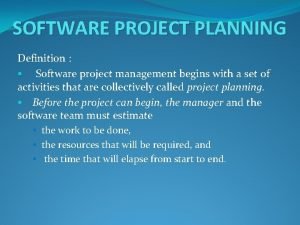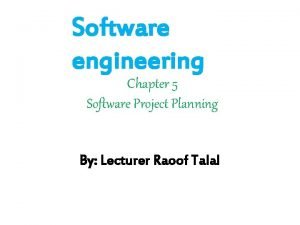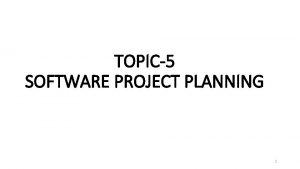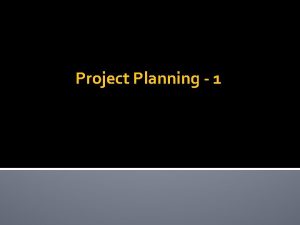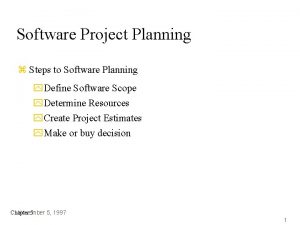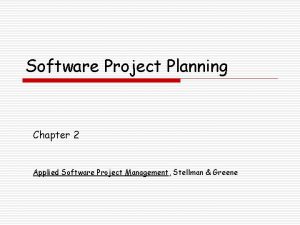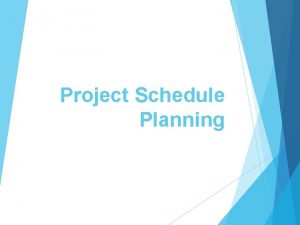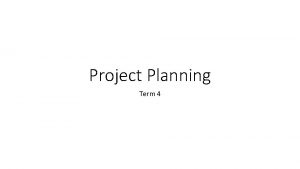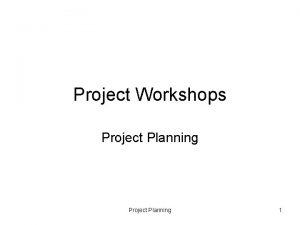Chapter 5 Software Project Planning 1 Software Project















- Slides: 15

Chapter 5 Software Project Planning 1

Software Project Planning The overall goal of project planning is to establish a pragmatic strategy for controlling, tracking, and monitoring a complex technical project. Why? So the end result gets done on time, with quality! 2

The Steps Scoping—understand the problem and the work that must be done Estimation—how much effort? how much time? Risk—what can go wrong? how can we avoid it? what can we do about it? Schedule—how do we allocate resources along the timeline? what are the milestones? Control strategy—how do we control quality? how do we control change? 3

Write it Down! Project Scope Estimates Risks Schedule Control strategy Software Project Plan 4

To Understand Scope. . . Understand the customers needs understand the business context understand the project boundaries understand the customer’s motivation understand the likely paths for change understand that. . . Even when you understand, nothing is guaranteed! 5

Cost Estimation project scope must be explicitly defined task and/or functional decomposition is necessary historical measures (metrics) are very helpful at least two different techniques should be used remember that uncertainty is inherent 6

Estimation Techniques past (similar) project experience conventional estimation techniques task breakdown and effort estimates size (e. g. , FP) estimates tools (e. g. , Checkpoint) 7

Functional Decomposition Statement of Scope perform a "grammatical parse" functional decomposition 8

Creating a Task Matrix Obtained from “process framework” framework activities application functions Effort required to accomplish each framework activity for each application function 9

Conventional Methods: LOC/FP Approach compute LOC/FP using estimates of information domain values use historical effort for the project 10

Example: LOC Approach 11

Example: FP Approach measurement parameter weight count number of user inputs 40 x 4 = 160 number of user outputs 25 x 5 = 125 number of user inquiries 12 x 4 = 48 number of files 4 x 7 = 28 number of ext. interfaces 4 x 7 = 28 algorithms 60 x 3 = 180 569 count-total complexity multiplier feature points . 84 478 0. 25 p-m / FP = 120 p-m 12

Tool-Based Estimation project characteristics calibration factors LOC/FP data 13

Estimation Guidelines estimate using at least two techniques get estimates from independent sources avoid over-optimism, assume difficulties you've arrived at an estimate, sleep on it adjust for the people who'll be doing the job—they have the highest impact 14

The Make-Buy Decision simple (0. 30) build reuse system X buy contract $380, 000 $450, 000 difficult (0. 70) $275, 000 minor changes (0. 40) major changes (0. 60) $310, 000 simple (0. 20) $490, 000 complex (0. 80) minor changes (0. 70) major changes without changes (0. 60) with changes (0. 40) $210, 000 (0. 30) $400, 000 $350, 000 $500, 000 15
 Software project definition
Software project definition Environmental resources in software engineering
Environmental resources in software engineering Planning a software project
Planning a software project Modern process transitions in spm
Modern process transitions in spm Software project evaluation
Software project evaluation Process indicators enable software project manager to
Process indicators enable software project manager to Boehm staffing principles
Boehm staffing principles Strategic planning vs tactical planning
Strategic planning vs tactical planning Goal achievement matrix
Goal achievement matrix Role segmentation workforce planning
Role segmentation workforce planning N planning
N planning Aggregate planning is capacity planning for
Aggregate planning is capacity planning for Short, medium and long term planning in education
Short, medium and long term planning in education Language policy and planning ppt
Language policy and planning ppt Aggregate planning is capacity planning for
Aggregate planning is capacity planning for Examples of aggregate planning
Examples of aggregate planning
